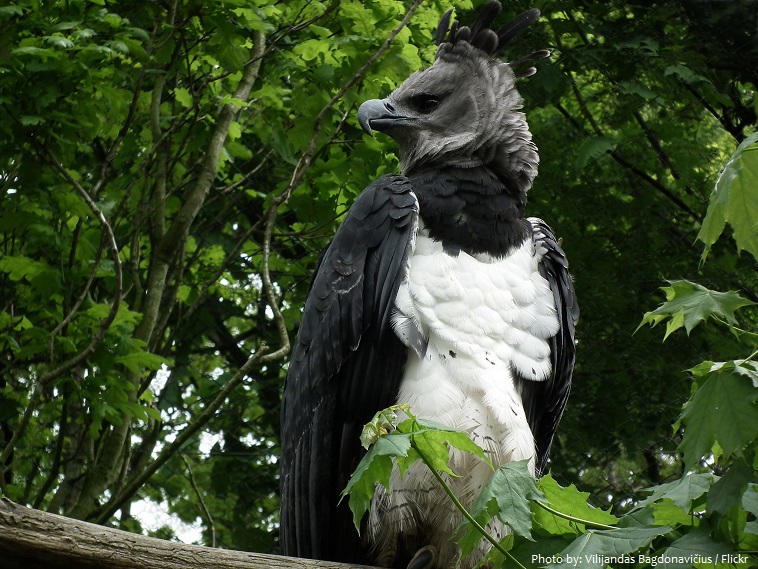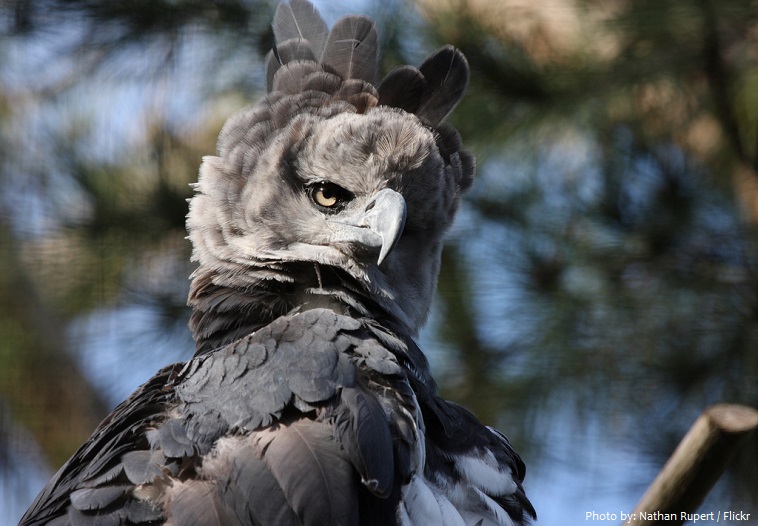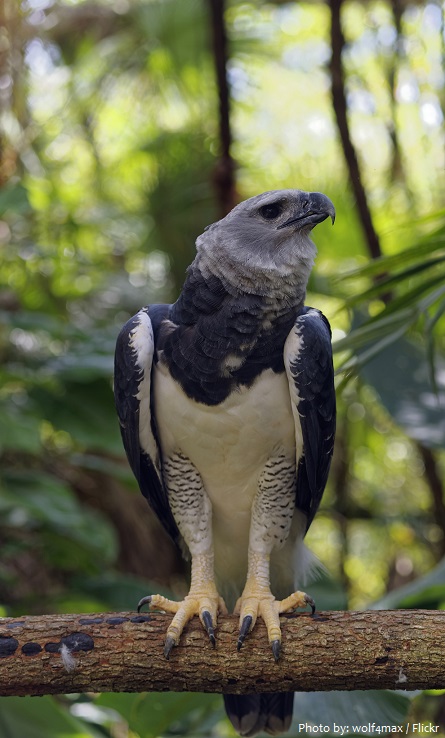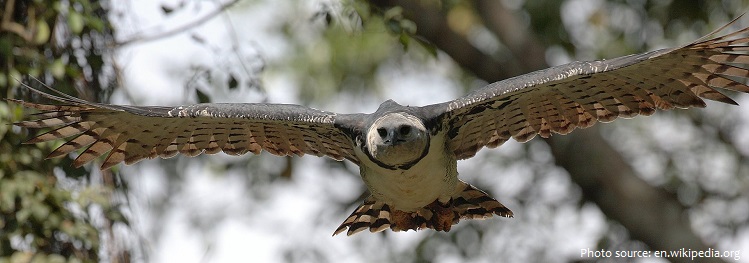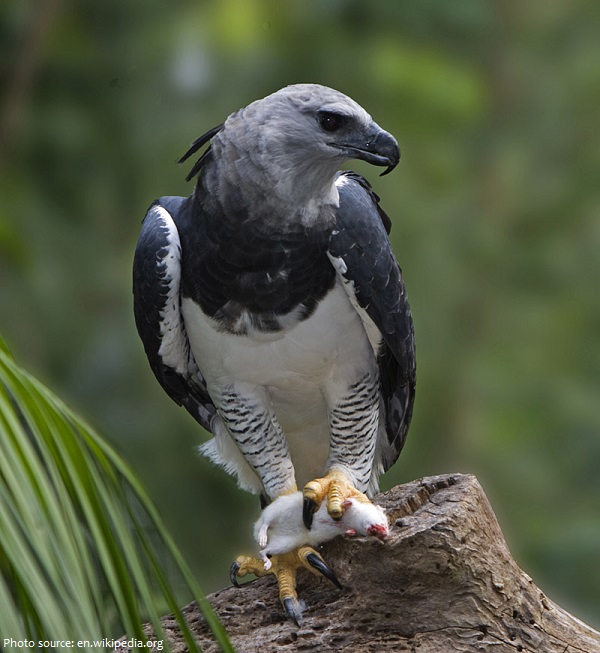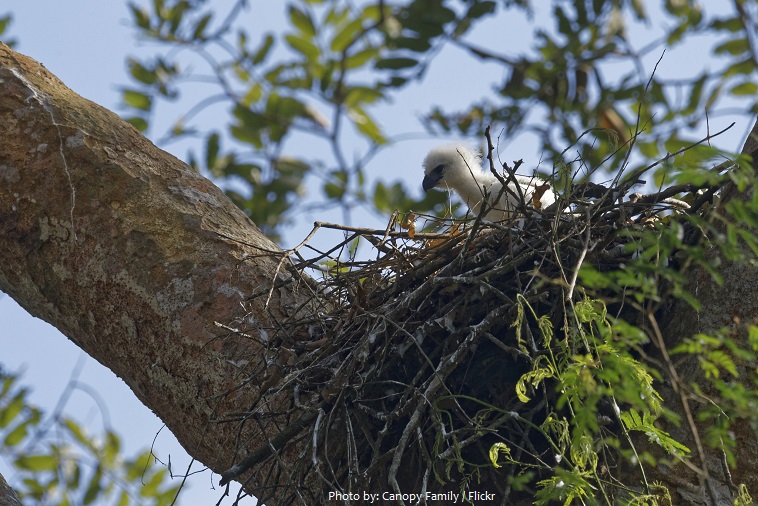The harpy eagle (Harpia harpyja) is one of the largest species of eagle.
Rare throughout its range, the harpy eagle is found from Mexico (almost extinct), through Central America and into South America to as far south as Argentina. The eagle is most common in Brazil, where it is found across the entire national territory.
Harpy eagles live in the canopies of tropical lowland rainforests. They prefer undisturbed forests but will also hunt along open patches of land. They generally are found in mid to upper levels of rain forest canopies where they are able to find preferred prey.
They typically occur below an elevation of 900 meters (3,000 ft), but have been recorded at elevations up to 2,000 meters (6,600 ft).
The lifespan of the harpy eagle is about 25 to 35 years in the wild and up to 40 years in captivity.
Harpy eagles are from 86.5 to 107 cm (2 ft 10 in to 3 ft 6 in) long and have a wingspan of 176 to 224 cm (5 ft 9 in to 7 ft 4 in).
Females are normally larger with an average weight of 6 to 9 kg (13 to 20 lb), while the males weigh an average of 4 to 5 kg (8.8 to 11 lb).
Harpy eagles possess the largest talons of any living eagle, they can be as large as a bear’s claws, and its legs can be almost as thick as a man’s wrist.
The coloration of the harpy eagle is deep gray, although they are white underneath. Their chests all feature prominent black ridges. The head is pale grey, and is crowned with a double crest. These eagles’ eye colors are generally either brown or gray. Their bills are black and their feet are yellow with black talons.
Harpy eagles are most often found in pairs as they form monogamous pairs that mate for life. The average area occupied by each breeding pairs was estimated at 4,300 hectares (11,000 acres).
They are solitary hunters which use their keen sense of sight to locate arboreal prey in thick rainforests.
Harpy eagles can potentially perch for up to 23 hours in search of prey. They are incredibly skilled in flight and are adept at maneuvering through their dense, forest habitat. They are diurnal and hunt during the day.
It has excellent vision and can see something less than 2 centimeters (1 inch) in size from almost 200 meters (220 yards) away.
A harpy eagle is capable, in a serious chase, of reaching speeds of 80 kilometers per hour (50 miles per hour). It dives down onto its prey and snatches it with outstretched feet.
They have short, broad wings and can fly almost straight up, too, so it can attack prey from below as well as above.
The harpy eagle preys on tree dwelling mammals like monkeys, sloths and opossums. Other partially arboreal and even land mammals are also preyed on given the opportunity, including porcupines, rodents, anteaters, armadillos, and even relatively large carnivores such as kinkajous, coatis, and tayras. Occasionally, this eagle also preys on other bird like macaws as well as on reptiles such as iguanas, tejus, and snakes.
Harpy eagles use vocalizations to communicate with one another and visual displays and vocalizations in mating rituals. They will often produce vocalizations while sitting on perches, which sound like “uahaaaau…uahaaaau…uahaaaau”.
The breeding season for harpy eagles coincides with the start of the rainy season which usually begins in April or May. Harpy eagles construct large nests that measure 1.2 meters (3.9 ft) thick and 1.5 meters (4.9 ft) across. These impressive nests are reused by breeding pairs every year. The female harpy eagle lays one or two white eggs in a large nest. Eggs are incubated for an average of 56 days. The first eaglet to hatch gets all the attention and is more likely to survive, while the other egg dies from lack of incubation. Both parents feed the chick for about 10 months. Harpy eagle chicks are ready to fledge at about five to six months of age, but they usually hang around the nest for over a year, begging a meal from its parents. Pairs of harpy eagles only breed once every 2 to 3 years.
Harpy eagles are near the top of a food chain but are preyed upon by snakes, jaguars and the much smaller ocelot.
Globally, the harpy eagle is considered Near Threatened by IUCN and threatened with extinction by CITES (appendix I).It is threatened primarily by habitat loss due to the expansion of logging, cattle ranching, agriculture, and prospecting.
The species name harpyja and the word harpy in the common name harpy eagle both come from Ancient Greek hárpuia (ἅρπυια). They refer to the Harpies of Ancient Greek mythology. These were wind spirits that took the dead to Hades, and were said to have a body like an eagle and the face of a human.
The harpy eagle is the national bird of Panama and is depicted on the coat of arms of Panama.
The harpy eagle is considered by many Brazilian indigenous tribes as the personification of tribal chiefs, a symbol of eagerness and prowess.
The 15th harpy eagle released in Belize, named “Hope”, was dubbed “Ambassador for Climate Change”, in light of the United Nations Climate Change Conference 2009.
The harpy eagle was the inspiration behind the design of Fawkes the Phoenix in the Harry Potter film series.
